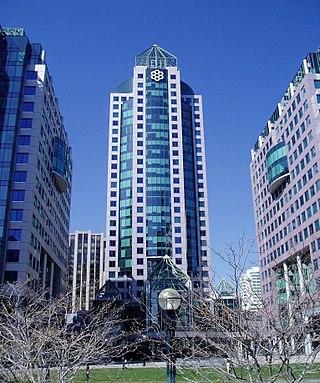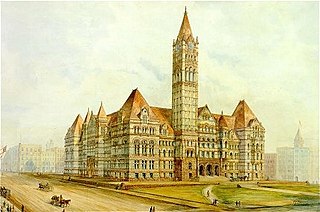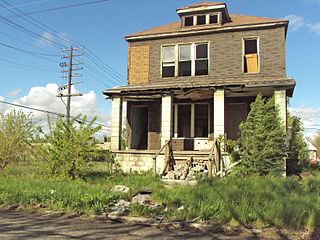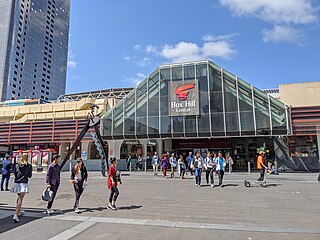Theoretical analyses
Joel Garreau in Edge City described the growth of cities on the edge of major urban areas, which became population and power centres in themselves.
Dale Johnston in Lost in the Suburbs described a cultural and political gap that occurred in New Jersey and Ontario in the early 1990s when suburban voters began to outnumber urban or rural voters, and began to perceive that they were paying taxes to provide urban areas with services that were not duplicated in their community. Meanwhile, suburban communities would export problems to the cities, typically in the form of drug addicts, homelessness, smog, prostitution and other crimes serving suburban residents, and the need to accommodate a large number of commuters and their sewage and parking requirements. As downtown residents and suburban voters became estranged, each perceived themselves subsidizing the other, and accordingly a common solution, called in both New Jersey and Ontario the Common Sense Revolution , transferred funds from urban needs to suburban sprawl, triggering a decline in urban quality of life in both places, as population further spread out and downtowns became more hostile to suburban visitors.

A suburb is an area within a metropolitan area which often contains most of the area's economic activity, which may include commercial and mixed-use. A suburb can exist either as part of a larger city/urban area or as a separate political entity. The name describes an area that is either more or less densely populated than an inner city. In many metropolitan areas suburbs rise in population during the day and are where most jobs are located; being major commercial and job hubs, many suburbs also exist as separate residential communities within commuting distance of a larger city. Suburbs can have their own political or legal jurisdiction, especially in the United States, but this is not always the case, especially in the United Kingdom, where most suburbs are located within the administrative boundaries of cities. In most English-speaking countries, suburban areas are defined in contrast to central city or inner city areas, but in Australian English and South African English, suburb has become largely synonymous with what is called a "neighborhood" in the US, and the term encompasses inner city areas.

The Province of Toronto is an urban secession proposal to split the city of Toronto and some or all of the Greater Toronto Area (GTA) from the province of Ontario into a new Canadian province. Secession of Toronto, the surrounding region, or any other portion of the province from Ontario to create a new province would require an amendment to the Constitution of Canada.
Urban secession is a city's secession from its surrounding region to form a new political unit.

Melvin Douglas Lastman was a Canadian businessman and politician who served as the third mayor of North York from 1973 to 1997 and 62nd mayor of Toronto from 1998 to 2003. He was the first person to serve as mayor of Toronto following the 1998 amalgamation of Metro Toronto and its six constituent municipalities. Lastman is also known for having founded the Bad Boy Furniture chain.

The Municipality of Metropolitan Toronto was an upper-tier level of municipal government in Ontario, Canada, from 1953 to 1998. It was made up of the old city of Toronto and numerous townships, towns and villages that surrounded Toronto, which were starting to urbanize rapidly after World War II. It was commonly referred to as "Metro Toronto" or "Metro".

Edge city is a term that originated in the United States for a concentration of business, shopping, and entertainment outside a traditional downtown or central business district, in what had previously been a suburban residential or rural area. The term was popularized by the 1991 book Edge City: Life on the New Frontier by Joel Garreau, who established its current meaning while working as a reporter for The Washington Post. Garreau argues that the edge city has become the standard form of urban growth worldwide, representing a 20th-century urban form unlike that of the 19th-century central downtown. Other terms for these areas include suburban activity centers, megacenters, and suburban business districts. These districts have now developed in many countries.

Urban sprawl is defined as "the spreading of urban developments on undeveloped land near a city". Urban sprawl has been described as the unrestricted growth in many urban areas of housing, commercial development, and roads over large expanses of land, with little concern for urban planning. In addition to describing a special form of urbanization, the term also relates to the social and environmental consequences associated with this development. Medieval suburbs suffered from the loss of protection of city walls, before the advent of industrial warfare. Modern disadvantages and costs include increased travel time, transport costs, pollution, and destruction of the countryside. The cost of building urban infrastructure for new developments is hardly ever recouped through property taxes, amounting to a subsidy for the developers and new residents at the expense of existing property taxpayers.

Suburbanization, or suburbanisation, is a population shift from central urban areas into suburbs, resulting in the formation of (sub)urban sprawl. As a consequence of the movement of households and businesses out of the city centers, low-density, peripheral urban areas grow. Sub-urbanization is inversely related to urbanization (urbanisation), which denotes a population shift from rural areas into urban centers.

Urban decay is the sociological process by which a previously functioning city, or part of a city, falls into disrepair and decrepitude. There is no single process that leads to urban decay.
Montreal was one of the cities in Quebec affected by the 2000–2006 municipal reorganization in Quebec. On January 1, 2002, all the municipalities on the island of Montreal were merged into the city of Montreal.

Highway revolts are organized protests against the planning or construction of highways, freeways, expressways, and other civil engineering projects that favor motor vehicles.

Toronto was founded as the Town of York and capital of Upper Canada in 1793 after the Mississaugas surrendered the land to the British in the Toronto Purchase. For over 12,000 years, Indigenous People have lived in the Toronto area. The ancestors of the Huron-Wendat were the first known groups to establish agricultural villages in the area about 1,600 years ago.
Transportation in the Canadian city of Toronto forms the hub of the road, rail and air networks in the Greater Toronto Area and much of southern Ontario. There are many forms of transport in the city, including railways, highways, and public transit. Toronto also has an extensive network of bicycle lanes and multi-use trails and paths.

Greater Lowell is the region comprising the city of Lowell, Massachusetts, and its suburbs. These lie in northern Middlesex County, Massachusetts; in the Merrimack Valley; and in southern New Hampshire.

Shrinking cities or urban depopulation are dense cities that have experienced a notable population loss. Emigration is a common reason for city shrinkage. Since the infrastructure of such cities was built to support a larger population, its maintenance can become a serious concern. A related phenomenon is counterurbanization.

An ethnoburb is a suburban residential and business area with a notable cluster of a particular ethnic minority population. Although the group may not constitute the majority within the region, it is a significant amount of the population. That can greatly influence the social geography within the area because of cultural and religious traditional values exhibited. Ethnoburbs allow for ethnic minority groups to maintain their individual identity, but that may also restrict their ability to fully assimilate into mainstream culture and society.

Medium-density housing is a term used within urban planning and academic literature to refer to a category of residential development that falls between detached suburban housing and large multi-story buildings. There is no singular definition of medium-density housing as its precise definition tends to vary between jurisdiction. Scholars however, have found that medium density housing ranges from about 25 to 80 dwellings per hectare, although most commonly sits around 30 and 40 dwellings/hectare. Typical examples of medium-density housing include duplexes, triplexes, townhouses, row homes, detached homes with garden suites, and walk-up apartment buildings.

Dadeland is a commercial district and urban neighborhood similar to an edge city, amid the sprawling metropolitan Miami suburbs of Kendall, Glenvar Heights, and Pinecrest, in the U.S. state of Florida, at the end of the Metrorail line.

Canada's cities span the continent of North America from east to west, with many major cities located relatively close to the border with the United States. Cities are home to the majority of Canada's approximately 35.75 million inhabitants —just over 80 percent of Canadians lived in urban areas in 2006.

The government of Cook County, Illinois, is primarily composed of the Board of Commissioners, other elected officials such as the Sheriff, State's Attorney, Treasurer, Board of Review, Clerk, Assessor, Cook County Circuit Court judges and Circuit Court Clerk, as well as numerous other officers and entities. Cook County is the only home rule county in Illinois. The Cook County Code is the codification of Cook County's local ordinances.
















